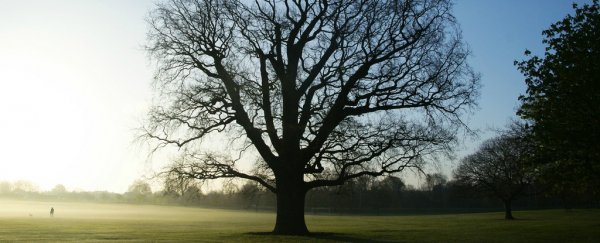Trees and forests have a special place in our hearts. Not only do they eat up CO2 and emit delicious oxygen for us to breathe, their mere presence can calm our nerves.
Because of this, trees get a lot of scientific attention, and a new study just asked a question you've probably never even considered: do trees sleep?
Yup, for the first time, an international team of researchers from Austria, Finland, and Hungary have analysed how trees change overnight using extremely accurate laser scans. The results suggest that trees move at night by drooping slightly and then spring back up in the morning, but is this sleep?
First, let's talk about what the team did to get their results. According to Patrick J. Kiger from Discovery News, two trees, one in Finland and one in Austria, were observed using highly detailed laser scanners that recorded a cloud of over a million data points per tree.
These laser scanners basically allowed the team to watch how the trees moved over time, even if that movement was slight.
When all was said and done, the team found that the trees drooped about 10 centimetres (3.93 inches) overnight with the lowest point happening right before dawn. Then, in the morning, the trees gradually straightened back up.
"Our results show that the whole tree droops during night which can be seen as position change in leaves and branches," said Eetu Puttonen from the Finnish Geospatial Research Institute. "The changes are not too large, only up to 10 cm for trees with a height of about 5 metres, but they were systematic and well within the accuracy of our instruments."
 Centre for Ecological Research
Centre for Ecological Research
Having the trees in different locations and measured under ideal conditions enabled the team to rule out environmental factors that may have been causing the droops, though it's important to point out that they only analysed two trees, a very small sample size.
"The next step will be collecting tree point clouds repeatedly and comparing the results to water use measurements during day and night," said Puttonen. "This will give us a better understanding of the trees' daily tree water use and their influence on the local or regional climate."
But is this sleep? Well, not in the way we experience it, but if the results are correct, it is definitely a night cycle. The drooping is most likely caused by a loss of internal water pressure within the tree's cells. This phenomenon is called turgor pressure, and it's common among most plants, reports Andy Coghlan for New Scientist.
Basically, turgor pressure is witnessed when photosynthesis stops, which lowers pressure, causing a droop. "It means branches and leaf stems are less rigid, and more prone to drooping under their own weight," explains András Zlinszky from the Centre for Ecological Research in Tihany, Hungary to New Scientist.
The team also suggests that the droop might be the result of the tree resting its branches. Trees typically hold up their branches and leaves to absorb more light during the day, but this is only a waste of energy at night. It will take further study for the team to understand more about what's happening.
The takeaway is that trees do move at night in a way that, to us humans, looks a lot like sleeping. While this isn't exactly what is going on, it's definitely an indication of a night cycle that has never been recorded until now.
The team's findings were published in the journal Frontiers in Plant Science.
